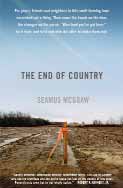SEJournal Online is the digital news magazine of the Society of Environmental Journalists. Learn more about SEJournal Online, including submission, subscription and advertising information.

BookShelf
The End of Country: Dispatches from the Frack Zone
By Seamus McGraw
Random House, $26
Reviewed by SUE SMITH-HEAVENRICH
In the fall of 2007, Seamus McGraw’s mother is planting bulbs when a woman drops by. She’s got a ring in her nose, an armful of gas leases and — in an unpardonable breach of etiquette — no time to admire the garden. When his mother seriously considers leasing the farm, McGraw heads to Dimock, Pa., with a fresh notebook and loads of questions.
In The End of Country, he delves beneath the issue of leasing to reveal the characters of those most impacted by drilling: Victoria Switzer, a retired school teacher who moved to Dimock to build her dream home; Ken Ely, who quarries bluestone from his farm just uphill of Switzer; and Rosemarie Greenwood, an aging dairy farmer who apologized for not baking muffins because her oven stopped working years ago.
McGraw’s no “parachute journalist” — he grew up in Dimock, riding his bike on the country roads and later filling his gas tank at Ely’s station. So when Ely tells him that the land is resilient, McGraw understands that Ely’s referring to past years of timbering, dairy farming, coal mining and, now, gas drilling.
“Sure, you could kill it if you took too much,” Ely said.
Greenwood leased so she could feed her cows and pay grain bills for one more year. For Ely, it was another way to work his land. For Switzer, it was an ambivalent faith that drilling might provide energy security to the region and the nation.
In this book, readers gain a close-up view of seismic operations and insight into how drillers make decisions. McGraw shows how land is cleared for well pads and access roads, helps readers hear the blasting, the hundreds of trucks grinding up the roads heavy with rig parts, the thousands of trucks bearing millions of gallons of water and chemicals used in blowing the rock apart two miles below the surface, the thousands of trucks hauling away the liquid waste — water so contaminated it must be injected deep into disposal wells or treated in special facilities.
But his real story is about character — the character of the country and the people who make up the community. Even as they debate the proffered leases, McGraw insists we see these people with our hearts. They are more than the decisions they make, he says. And the leases are less about money than about hope for a better future, one in which young men and women are not sent off to war to secure access to foreign oil fields.
As more drillers move into the countryside, those who welcomed them become acutely aware of just how disruptive the industrialized drilling process is to their way of life.
Those who haven’t leased feel under siege as the number of landmen multiply. "Their phones rang constantly, their mailboxes were crammed with letters representing Chesapeake and Devon and a host of other companies large and small that none of them had ever heard of," McGraw wrote.
Things shift; neighbors seem more guarded. Whenever conversation drifts too close to leases and recent offers, a chasm of silence opens up. Neighbors suddenly seem a lot more concerned about their property lines, people begin studying their deeds.
There was, McGraw explains, a vague but growing sense that something fundamental had changed — that, in the face of the gas company money, the community was starting to come apart. Though the land was resilient — forests reclaiming old roads and foundations, leaving not a trace of the civilization that had come before — people are not. Just the promise of money was enough to make neighbors view each other with suspicion.
“People who had always stoically shared the hardships of rural life seemed no longer willing to share anything at all,” McGraw writes. It was, as one woman put it, “the end of country.”
Sue Smith-Heavenrich writes about science and agriculture from atop the Marcellus Shale in upstate New York.
* From the quarterly newsletter SEJournal, Spring 2012. Each new issue of SEJournal is available to members and subscribers only; find subscription information here or learn how to join SEJ. Past issues are archived for the public here.













 Advertisement
Advertisement 



